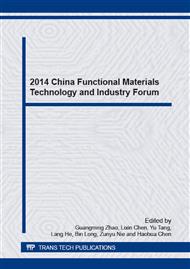p.596
p.604
p.610
p.615
p.621
p.627
p.631
p.635
p.642
Preparation and Properties of Electroless Ni-P-β-SiC Composition Coating
Abstract:
Through orthogonal test of Ni-P chemical plating process optimization to determine the optimum process recipe, the Ni-P-β-SiC composite coating were prepared by chemical plating method. The deposition rate, microhardness, composition and organization of Ni-P-β-SiC composite coating are observed and analyzed by scanning electron microscopy (SEM), vivtorinox microhardness tester, X ray diffraction (XRD) and energy spectrum analysis (EDS). The influences of β-SiC particle concentration in bath on the solution of composite coating deposition rate and microhardness. The results show that the influence of composite coating deposition rate and microhardness are NiSO4•6H2O, NaH2PO2•H2O, C3H6O3, and PH. The optimum process conditions: NiSO4•6H2O 25 g/L, NaH2PO2•H2O 27 g/L, C3H6O3 27 ml/L, PH 5.2. It was found that the Ni-P-β-SiC composite coating with 5g/L β-SiC particles exhibited a maximum deposition rate and microhardness, the deposition rate of composite coating is 12.32μm/h, microhardness is 567.93HV0.05.
Info:
Periodical:
Pages:
621-626
Citation:
Online since:
December 2014
Authors:
Price:
Сopyright:
© 2015 Trans Tech Publications Ltd. All Rights Reserved
Share:
Citation:


